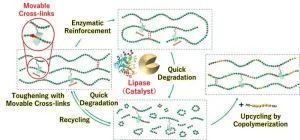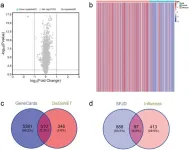(Press-News.org) New Haven, Conn. — Paleontologists have identified fossils of an ancient species of bug that spent the past 450 million years covered in fool’s gold in central New York.
The new species, Lomankus edgecombei, is a distant relative of modern-day horseshoe crabs, scorpions, and spiders. It had no eyes, and its small front appendages were best suited for rooting around in dark ocean sediment, back when what is now New York state was covered by water.
Lomankus also happens to be bright gold — thanks to layers of pyrite (fool’s gold) that have crept into its remains.
And the gold color isn’t just for show. The pyrite, located in a fossil-rich area near Rome, New York, known as “Beecher’s Bed,” helped to preserve the fossils by gradually taking the place of soft-tissue features of Lomankus before they decayed.
“These remarkable fossils show how rapid replacement of delicate anatomical features in pyrite before they decay, which is a signature feature of Beecher’s Bed, preserves critical evidence of the evolution of life in the oceans 450 million years ago,” said Derek Briggs, the G. Evelyn Hutchinson Professor of Earth and Planetary Sciences in Yale’s Faculty of Arts and Sciences.
Briggs is co-author of a new study in Current Biology describing the new species. He is also a curator at the Yale Peabody Museum.
Briggs and his co-authors said Lomankus, which is part of an extinct group of arthropods called Megacheira, is evolutionarily significant in several ways.
Like other Megacheirans, Lomankus is an example of an arthropod with an adaptable head and specialized appendages (a scorpion’s claws and a spider’s fangs are other examples). In the case of Lomankus, its front appendages bear a trio of long, flexible, whip-like flagella — which may have been used to perceive its surroundings and detect food.
“Arthropods typically have one or more pairs of legs at the front of their bodies that are modified for specialized functions like sensing the environment and capturing prey,” said Luke Parry, a former Yale postdoctoral researcher who is now an associate professor at the University of Oxford, and co-corresponding author of the study. “These special legs make them very adaptable, somewhat like a biological Swiss army knife.”
In addition, the Lomankus fossils indicate that Megacheirans continued to evolve and diversify longer than previously thought. Lomankus is one of the only known Megacheirans to have survived past the Cambrian Period (485 to 541 million years ago) and into the Ordovician Period (443 to 485 million years ago). Paleontologists believe Megacheirans were largely extinct by the beginning of the Ordovician Period.
The new Lomankus fossils also have several ties to Yale’s paleontological efforts, going back more than a century.
The site where they were discovered, Beecher’s Bed, is named for Charles Emerson Beecher, who was head of the Yale Peabody Museum from 1899 until 1904. Beecher published classic papers on the anatomy and relationships of trilobites (one of the earliest arthropod groups) from the site, and his material was studied and expanded upon by other scientists for generations.
Briggs was one of them. His first paper on Beecher’s Bed fossils was published in 1991, and as curator of invertebrate paleontology at the Peabody in the early 2000s (and subsequently director of the museum), he arranged for Yale to lease the site for field studies until 2009.
Paleontologist Yu Liu of Yunnan University in China, co-corresponding author of the study, contacted Briggs about the new fossils from Beecher’s Bed, which he had acquired from a Chinese fossil collector. Briggs then brought in Parry, his former postdoc, with whom he was already collaborating on research about similar fossils at the Peabody.
“The preservation is remarkable,” Briggs said. “The density of the pyrite contrasts with that of the mudstone in which they were buried. Their details were extracted based on computed tomography [CT] scanning, which gave us 3D images of the fossils.”
The new fossil specimens have been donated to the Peabody.
# # #
END
Osaka, Japan—Achieving a sustainable society requires the development of advanced degradable plastics, or polymers, which are molecules composed of long chains of repeating units. The goal of a resource-circulating society is now one step closer thanks to the efforts of a team from Osaka University that has developed tough biodegradable plastics by including movable crosslinking groups.
In a study published this month in Chem, the researchers have revealed that developing polymers with movable crosslinks not only increases their strength but also promotes degradation by enzymes under mild conditions.
Plastics and polymers need to achieve both desirable performance ...
A new study by UCLA Health reveals that hospital emergency departments may be missing signs of suicidal thoughts and behaviors in children, boys and Black and Hispanic youth.
The research, published in the journal JAMA Open Network, analyzed electronic health records of nearly 3,000 children and teenagers presenting to two emergency departments in southern California for mental health reasons. Using machine learning algorithms, the researchers determined standard medical record surveillance methods miss youth with suicide-related emergencies. These methods disproportionately missed suicide-related visits among Black, Hispanic, male, and preteen youths, compared with ...
Background and objectives
Shufeng Jiedu Capsules (SFJD), a traditional Chinese medicine preparation, are widely used in the clinical treatment of influenza, yet their mechanism of action remains unclear. This study aimed to systematically explore the molecular mechanism of SFJD in the treatment of influenza using network pharmacology and bioinformatics techniques.
Methods
The active ingredients of SFJD were retrieved from traditional Chinese medicine databases, and their targets were identified using the Swiss Target Prediction and TCMSP databases. Influenza disease genes were obtained from the GEO, GeneCards, and DisGeNET ...
Routine use of an orbital atherectomy device to remove calcium from severely blocked coronary arteries before patients undergo cardiac stenting procedures does not improve outcomes, a Mount Sinai-led study has found.
The results of the ECLIPSE study were announced during a late-breaking trial presentation at the Transcatheter Cardiovascular Therapeutics Annual Meeting on Tuesday, October 29. This is the first large-scale study to study this specific device in severely calcified lesions, and the results support reserving its use for extreme cases.
“Operators across the United States currently have different thresholds ...
OAK BROOK, Ill. – Knowing a patient’s symptoms helps radiologists in lumbar spine MRI interpretation and diagnosis, according to a study published today in Radiology, a journal of the Radiological Society of North America (RSNA).
MRI is the most important imaging exam in patients with back pain or sciatica because it shows nearly all degenerative and structural abnormalities of the spine.
However, MRI often shows spinal abnormalities in individuals who do not have symptoms. Because the same abnormalities can ...
Prostate cancer is the second most common cancer in men, and almost 300,000 individuals are diagnosed with it each year in the U.S. To develop a consistent method of estimating prostate cancer size, which can help clinicians more accurately make informed treatment decisions, Mass General Brigham researchers trained and validated an AI model based on MRI scans from more than 700 prostate cancer patients. The model was able to identify and demarcate the edges of 85% of the most radiologically aggressive prostate lesions. Tumors with a larger volume, as estimated by the AI model, ...
A new synthesis of global evidence highlights a strong connection between family violence and long-term health consequences, significantly impacting the psychological and physical well-being of millions worldwide. This comprehensive review, the first of its kind, synthesises the findings from the most rigorous studies on child maltreatment and intimate partner violence, uncovering alarming patterns in the long-term effects of family violence.
According to the study, led by Matthias Burghart of the Max Planck Institute for the Study of Crime, Security, and Law, and Sophia ...
Leading ethics experts and researchers have co-authored a breakthrough paper calling for new governance and legal rules to guide application of emerging technology to preserve organs for transplant.
Current law and guidance are inadequate for emerging biopreservation technologies that will allow long-term storage of human organs for transplantation. The technology is much needed to address the severe time constraints that currently limit the viability of donor organs. Those constraints have contributed to a severe organ shortage, which affects patients throughout ...
Background and objectives
Fuzi, the processed product of daughter roots of Aconitum carmichaelii Debx., is a well-known Chinese medicine for the treatment of heart failure (HF) and related cardiac diseases. This study aimed to investigate the molecular mechanism of the cardioprotective effects of Fuzi water decoction (FWD) and Fuzi water-soluble alkaloids (FWA) on the model of HF.
Methods
The HF model of rats was prepared through intravenous injection of propafenone hydrochloride. The normal group, model group, FWD-treated groups (1.25 g/kg, 2.5 g/kg, 5 g/kg) and positive group (Shenfu Injection, 3.3 mL/kg) were set up. Heart rate, LV+dp/dtmax, and ...
Background and objectives
Albumin is a major prognostic factor for patients with advanced liver disease, dependent on its concentration and biological activity. This study aimed to improve the method of active albumin detection and elucidate its predictive validity of albumin activity across hepatic disease progression and etiology.
Methods
This study synthesized a novel ratiometric fluorescent probe with an improved structure of 2′-FBPBN. The technique was used to detect native human albumin (HA) activity in 244 patients with hepatitis B cirrhosis (LC) and 66 patients with hepatocellular carcinoma (HCC). Clinical and laboratory data were also collected.
Results
Patients ...


